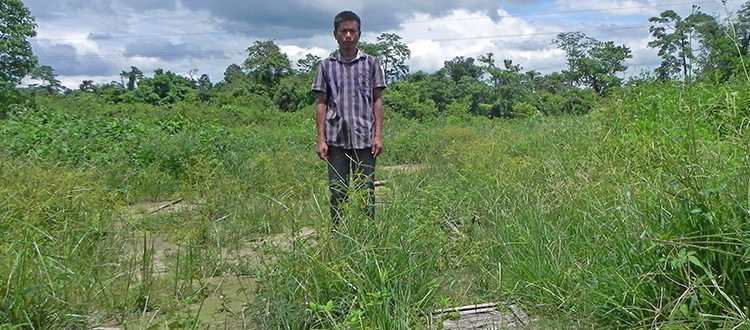The Village that Moved
By Pranav Capila
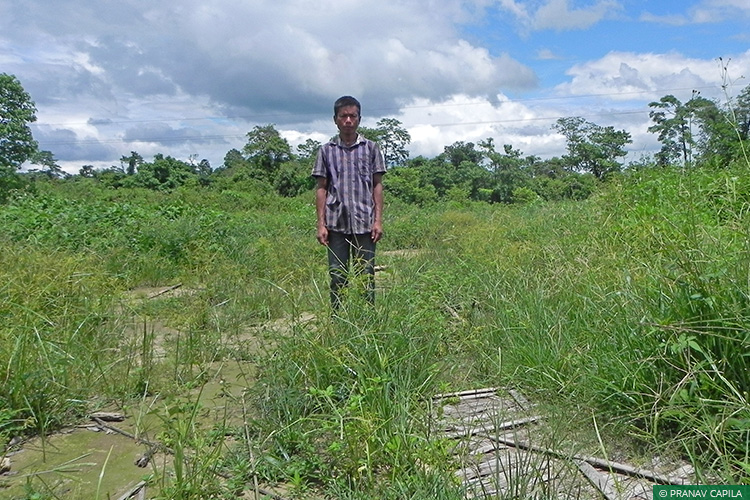
Khoi Terang stands in the middle of the jungle, squinting solemnly into my camera lens. The broken pieces of the bamboo fence at his feet are all that remain of the house he once lived in. Scattered around us, undigested by the thick undergrowth, is similar debris from other houses: splintered memories of the hamlet named after Khoi’s father, Ram Terang.
As we walk around the village that once was, Khoi stops and points to a series of large circular indentations on the jungle floor. Elephant footprints. He looks down at them, and at the jungle all around us. And then he smiles.
He smiles because we are not standing amidst the desperate ruins of his village. Ram Terang, or New Ram Terang as it is now referred to, flourishes a few kilometres uphill from this spot. These are remnants of a life Khoi once lived: a life of great poverty, and terrible hardship, and constant terror.
The Remaking of Ram Terang
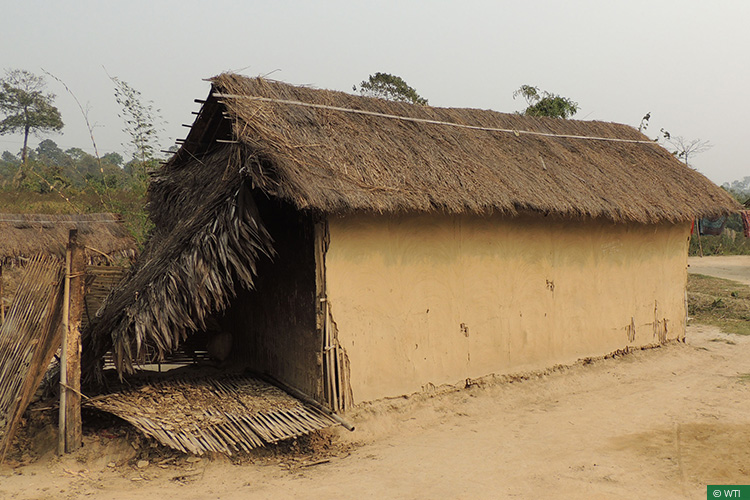 A house in Old Ram Terang damaged by elephants
A house in Old Ram Terang damaged by elephants
What happens to a village on the migratory path of an elephant herd? Sleep withers during the harvest season, when conflict reaches its peak. Farmers who have worked tirelessly during the day are forced to guard their crops by night. They dig trenches and erect fences, but the elephants, brilliant collaborative problem solvers, are not deterred. Each night becomes an ordeal of burst crackers and drumbeats and the mad intercutting terror and fury of humans and elephants chasing or being chased. Success provides but a temporary respite; tomorrow the rock must be rolled up the hill again.
Stress levels rise. Finally, some night someone gets careless. Or is too old, or too tired to run fast enough. Some night someone loses their life.
The elephants may alter their behaviour but do not stop using high risk areas of their home ranges. But the farmers do give up: in places where conflict is especially severe they sometimes abandon their farms and seek other ways to make ends meet.
Some years ago the villagers of Ram Terang teetered on a similar edge of despair. Their hamlet, all of 19 houses nestled in the autonomous tribal Karbi Anglong Hills in Assam, lay right in the middle of an ancient elephant migratory route, today a vital habitat linkage or ‘corridor’ connecting Kaziranga National Park with the Nambor-Daigrung Wildlife Sanctuary.
“Whatever we cultivated, the elephants raided”, says Khoi, the hereditary village headman. “Our kitchen gardens, our bamboo, and of course, our paddy. They always came when the paddy crop ripened.”
As the elephants arrived during their annual migrations the drama would begin: the nightly raids and rebuffs, the trumpeting and shouts, the flaming torches, the terror. Someone would be injured, a politician might come bearing promises and lies, but nothing would change. With the next crop cycle, as the paddy ripened, the story would repeat.
“For us”, Khoi says, “things became really desperate some ten years ago when a woman fleeing with her child was killed. We are a small community and that really hit us hard.”
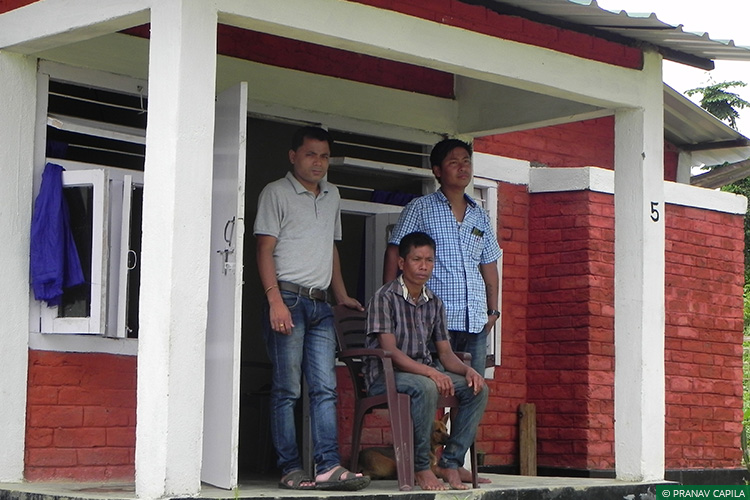 Khoi Terang with WTI team members in front of his new house
Khoi Terang with WTI team members in front of his new house
Wildlife Trust of India (WTI) began working on conflict mitigation in the area in 2009-10. With assistance from the Japan Tiger and Elephant Fund (JTEF), aid was arranged for the village, an electric fence strategically placed, a bio-fence using chillies experimented with. A sociologist was also placed in the village and an Elephant Cup football tournament organised to ameliorate the local outlook towards elephant conservation.
These were, however, just band-aids – temporary measures meant to alleviate certain aspects related to conflict, and building towards the more lasting solution: relocation.
“When WTI first broached the subject I was dismissive”, Khoi declares. “It was unthinkable that we should give up our land and move elsewhere.”
In 2010 WTI began the slow march towards a consensus for voluntary relocation, working in partnership with the Karbi Anglong Autonomous Council, the Assam Forest Department, UK-based NGO Elephant Family and IUCN Netherlands. An assessment of the community’s living conditions and their dependence on the forest was conducted. The community, below ‘Below Poverty Line’ one might say, were subsistence farmers and had a traditional bond with the forest. They would not live far from it.
Community mobilisers such as WTI’s Yuri Pator and Borsali Teron played an important role in turning the tide of opinion. “Ultimately, the villagers accepted because it was clear everything was being taken care of”, says Yuri. “They received patta land, permanent dwellings, better facilities, sustainable livelihoods. They were living hand-to-mouth earlier, farming, working as daily wage labourers, selling firewood, barely getting by.”
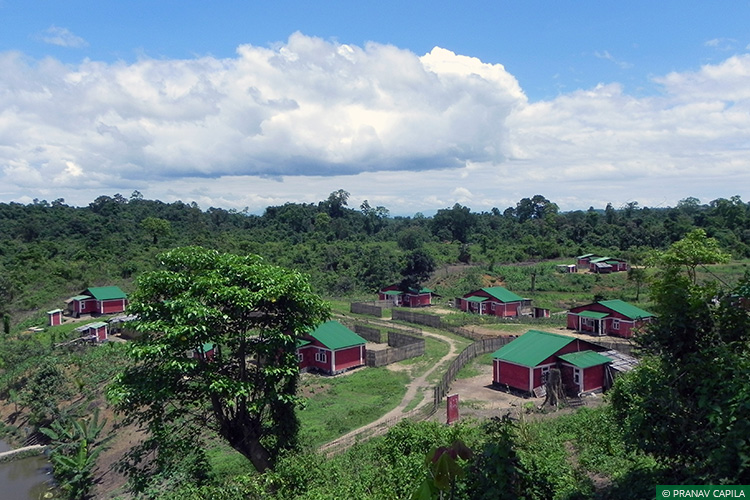 New Ram Terang as it appears today from the church that overlooks it
New Ram Terang as it appears today from the church that overlooks it
Land for the new village was acquired at the end of 2012. In 2013 the traditional king of Karbi Anglong laid the foundation stone for New Ram Terang. One by one the houses were constructed, until finally, in November 2015, WTI Executive Director & CEO Vivek Menon and Elephant Family CEO Ruth Powys handed a ceremonial bunch of keys to a gaon burha, a village elder, as Karbi leaders applauded. The villagers all moved into their new homes in March 2016.
The 19 green-roofed red brick houses of New Ram Terang lie a few kilometres uphill from the old village, out of the elephants’ migratory path. “We are finally free of conflict”, says Khoi. “We have peace of mind and that has been the main thing. But beyond that, step by step, our lives are improving.”
The loud drumming of rain on the roofs of New Ram Terang announces that improvement – but the change from thatch to tin, from mud to brick, is just one aspect of this transformation. With community paddy fields, citrus plantations and a pond for fisheries, the villagers now have a measure of self-sufficiency. There is a primary school that their children can attend. And infrastructure for the village’s electrification is currently being installed.
“WTI’s goal, when we started down this path with Elephant Family, was to create a model village”, says Dilip Deori, who heads WTI’s Kaziranga – Karbi Anglong Link Project. “And we are getting there, piece by piece.”
Meanwhile, at the site where Old Ram Terang once stood, the elephants now have right of passage through the Kalapahar-Daigrung elephant corridor.
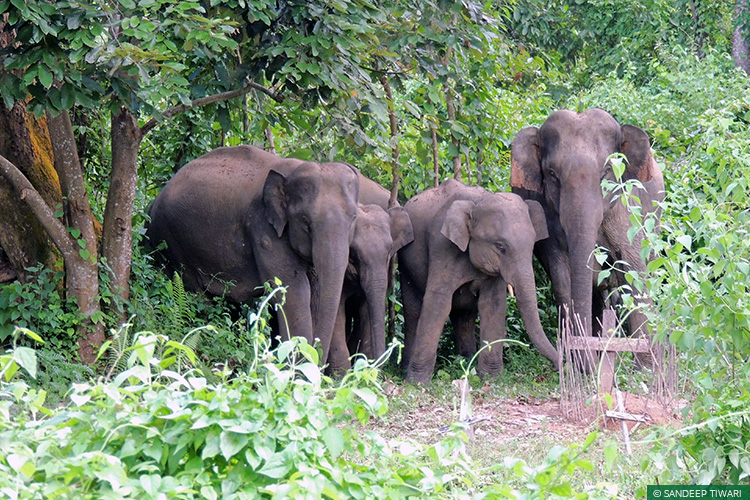 Elephants passing through the Kalapahar-Daigurung corridor in Karbi Anglong, July 2016
Elephants passing through the Kalapahar-Daigurung corridor in Karbi Anglong, July 2016
Excerpted with permission from the article ‘The Village That Moved’, published in Sanctuary Asia, December 2016. The author is a Delhi based writer-editor and can be reached at pranav@secondskin.media.

